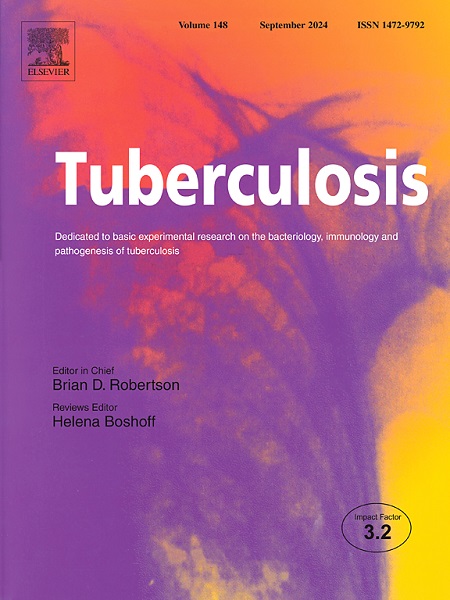在中间尺度评估基因内的选择为结核分枝杆菌临床分离株的阳性选择提供了强有力的基因鉴定。
IF 2.9
3区 医学
Q3 IMMUNOLOGY
引用次数: 0
摘要
多项研究报告了结核分枝杆菌(Mtb)基因组中的基因正在进行多样化选择,这是基于结核分枝杆菌临床分离株的遗传变异。这些可能反映了对与现代结核病临床治疗相关的选择压力的适应。在这些被选择的基因中,有许多(但不是全部)与耐药性有关。这些研究大多在基因水平上评估选择。然而,正选择可以在不同的尺度上进行评估,包括ORF内的单个位点(密码子)和局部区域。在本文中,我们使用GenomegaMap(一种计算选择的贝叶斯方法)来评估结核分枝杆菌基因组中所有三个水平的基因选择。我们提供的证据表明,中间分析(密码子窗口)产生了最可信的候选基因选择列表(不包括PPE和PE_PGRS基因,由于频繁的测序错误,它们的预测可靠性较低)。这种方法的另一个优点是,它可以识别蛋白质中处于选择压力下的特定区域,这对结构和功能解释很有用。在对两组单独收集的结核分枝杆菌临床分离株(来自摩尔多瓦和一组具有全球代表性的菌株)进行分析时,我们观察到53和173个重要基因在选择中,重叠率为36%。正在选择的基因清单包括许多耐药基因,以及以前报道的正在选择的其他基因(resR, phoR)。在耐药基因中鉴定的特定选择区域显示与已知参与耐药的蛋白质结构特征相对应,支持该方法的准确性。在一些esx -1相关基因中也观察到正选择,提示对免疫压力的适应。本文章由计算机程序翻译,如有差异,请以英文原文为准。
Evaluating selection at intermediate scales within genes provides robust identification of genes under positive selection in M. tuberculosis clinical isolates
Multiple studies have reported genes in the M. tuberculosis (Mtb) genome that are under diversifying selection, based on genetic variants among Mtb clinical isolates. These might reflect adaptions to selection pressures associated with modern clinical treatment of TB. Many, but not all, of these genes under selection are related to drug resistance. Most of these studies have evaluated selection at the gene-level. However, positive selection can be evaluated on different scales, including individual sites (codons) and local regions within an ORF. In this paper, we use GenomegaMap, a Bayesian method for calculating selection, to evaluate selection of genes in the Mtb genome at all three levels. We present evidence that the intermediate analysis (windows of codons) yields the most credible list of candidate genes under selection (excluding PPE and PE_PGRS genes, which are predicted less reliably due to frequent sequencing errors). A further advantage of this approach is that it identifies specific regions within proteins that are under selective pressure, which is useful for structural and functional interpretation. In an analysis of two separate collections of Mtb clinical isolates (from Moldova; and a globally-representative set), we observed 53 and 173 significant genes under selection, with 36 % overlap. The lists of genes under selection include many drug-resistance genes, as well as other genes that have previously been reported to be under selection (resR, phoR). The specific regions under selection identified within drug-resistance genes are shown to correspond to protein structural features known to be involved in resistance, supporting accuracy of the method. Positive selection in several ESX-1-related genes was also observed, suggesting adaptation to immune pressure.
求助全文
通过发布文献求助,成功后即可免费获取论文全文。
去求助
来源期刊

Tuberculosis
医学-呼吸系统
CiteScore
4.60
自引率
3.10%
发文量
87
审稿时长
49 days
期刊介绍:
Tuberculosis is a speciality journal focusing on basic experimental research on tuberculosis, notably on bacteriological, immunological and pathogenesis aspects of the disease. The journal publishes original research and reviews on the host response and immunology of tuberculosis and the molecular biology, genetics and physiology of the organism, however discourages submissions with a meta-analytical focus (for example, articles based on searches of published articles in public electronic databases, especially where there is lack of evidence of the personal involvement of authors in the generation of such material). We do not publish Clinical Case-Studies.
Areas on which submissions are welcomed include:
-Clinical TrialsDiagnostics-
Antimicrobial resistance-
Immunology-
Leprosy-
Microbiology, including microbial physiology-
Molecular epidemiology-
Non-tuberculous Mycobacteria-
Pathogenesis-
Pathology-
Vaccine development.
This Journal does not accept case-reports.
The resurgence of interest in tuberculosis has accelerated the pace of relevant research and Tuberculosis has grown with it, as the only journal dedicated to experimental biomedical research in tuberculosis.
 求助内容:
求助内容: 应助结果提醒方式:
应助结果提醒方式:


